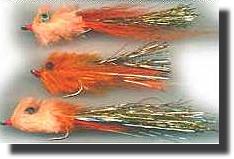Fly-fishing for Prairie Pike, Part 3
Flies for pike and other gear
By Clive Schaupmeyer
This the third of a series of five articles about fly-fishing for pike.
The articles include: introduction; equipment and rigging; flies and other
gear; when and where; and techniques.
FLIES
There are many published fly patterns for pike, and most fly shops carry
a few local designs. Any number of four- to six-inch-long streamers of
colourful synthetic hair and flash filaments, will catch pike when they
are feeding. My two favorite colour combinations include brass flash filaments
mixed with orange artificial hair, and chartreuse and yellow artificial
hair, again with a few flash filaments. Red and white, and yellow and red
are also popular colours for pike flies. Streamers that look more like
baitfish such as shiners and whitefish are also used. They have light-
coloured undersides, dark backs and a few silvery flash filaments.

Variations on the Great Pumpkin
Some anglers prefer long streamers of up to eight or 10 inches, but
such large flies tied with artificial fibres can result in false hookups – a
fish on for a few seconds then gets off. Apparently the teeth temporarily
tangle in the long fibres, then pull free because the jaws aren't anywhere
near the hook at the head of the fly. A common solution for this problem
is to add a second hook (called a trailer or stinger) to the back end of
the fly. However, it is more difficult to remove a fly with two hooks,
and there's a greater chance of an unsuccessful release. I've tried huge
flies and find that more pike stay connected to smaller streamers–meaning
no more than six inches long. Again, my ideas differ from many pike pros,
who insist that big eight - to 10 - inch flies are a must for catching trophy
pike, so maybe big streamers are worth tying and trying. Perhaps this is
why I have never landed a trophy pike, but my friends who do catch big
pike also use smaller flies. Besides, is a five - or six-inch-long streamer
really that small?

Perch fly
Tie or buy pike streamers with artificial fibers that do not hold water.
Natural tying materials like rabbit fur and marabou feathers look great
below the surface, but they absorb lots of water and can be quite difficult
to cast because of the added weight.
Most of my pike flies are tied on No. 2/0 and 3/0 short-shank hooks.
Others use long-shanked hooks down to size 2. Weed guards made from thick
monofilament are helpful when fishing through weed beds, especially later
in the year. Some patterns use stiff bucktail hairs that cover the hook
and reduce weed interference. Brass eyes add flash, and the extra front-end
weight presumably adds fish-attracting action to pike flies. And no one
can deny that those eyes look so damned cute.
All hooks should be debarbed for ease of removal from pike. You will
also appreciate the ease with which an impaled debarbed pike fly will slip
out of the back of your hand. (The voice of experience. . .)
OTHER STUFF
There are not many pieces of pike fly-fishing equipment that are as
mandatory as jaw spreaders, and either long-nosed forceps or needle-nose
pliers. Occasionally, pike will take the hook quite deep, so the jaw spreaders
and long forceps are a must for hook removal without hurting the fish – or
yourself. Many jaw spreaders have pointed hook ends which can damage pike
jaws. To prevent them from piercing the jaw tissue, I slip a few inches
of thick surgical tubing over the sharp ends. Others wrap the pointed ends
with electrical tape.

Jaw spreaders with rubber guards
Also handy for making on-water adjustments and repairs are an extra
spool of monofilament leader, steel leader, cigarette lighter, split shot,
hook sharpener, wire side-cutters and needle-nose pliers. Light cotton
gloves help grasp slippery pike.
Chest waders are required for spring wading in shallow bays, or paddling
around in a float tube or pontoon boat. On most lakes, a small personal
float craft or boat is required to get to the pike- feeding grounds after
they leave the shallow breeding bays.
Next week: When and where to fly-fish for pike. ~ Clive Schaupmeyer
Our Man In Canada Archives
|

 April 26th, 1999
April 26th, 1999




 April 26th, 1999
April 26th, 1999


